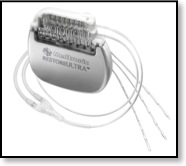SOMA Orthopedics
Medical Group Inc.
This device delivers small
electrical pulses to the spinal cord thereby
changing the pain signals reaching your
brain.
Before proceeding with the actual implant, a series
of steps will have to be taken. First, you will
need to be evaluated by a Medical Psychologist with
experience in chronic pain management. Assuming
that your psychological profile does not
contraindicate the implant therapy, you will then
have to undergo an "outpatient
trial".
This trial is design to find out if you get any
benefit from the treatment before committing to the
permanent implant.
How
Is The Trial Conducted?
The trial
is done in an out-patient basis. You will have a
temporary leads placed under light sedation with
the assistance of an x-ray machine. You will then
go home with the leads in place for the next 5 to 7
days. The only restriction is essentially not
showering since the lead are connected to the
spine. Ideally, you should try to perform normal
activities to see if the therapy is beneficial.
What Is The Purpose Of The Trial?
Provide
the patient with the best possible results, by
identifying any possible problems, early. The trial
is similar to a "Test Drive" prior to purchasing a
car. It allows you to see how it feels, before you
commit to it.
 What
Do You Look For In A Trial?
What
Do You Look For In A Trial?
We look
for two things. The first is to see if the
stimulation will be effective in providing you with
the desired relief of the pain. The second is to
find out if you will be able to tolerate the
stimulation well without experiencing any side
effects.
What
Possible Problems Could We Encounter During The
Trial?
Just like
any other medical procedure, it has its risks and
possible complication. Some of these may include
bleeding, infection, nerve damage and death. These
are rare, but need to be mentioned because they are
always possible. The more common side effects are:
soreness at the trial site, itching, and rash.
Implantation:
If the
trial is deemed a success, then a permanent implant
can be considered.
Will
The Procedure Hurt?
The procedure involves inserting a long needle
through skin and deeper tissues (like a "tetanus
shot") to the epidural space. So, there is some
discomfort involved. However, we numb the skin and
deeper tissues with a local anesthetic using a very
thin needle first. Most of the patients also
receive intravenous sedation and analgesia, which
makes the procedure easy to
tolerate.
Will
I Be "Put Out" For This
Procedure?
No, the placement of the stimulator and leads are
done under local anesthesia and intravenous
sedation. The amount of sedation given generally
depends upon the patient tolerance. The procedure
is divided in two stages. The first stage (lead
placement) is done with the local anesthesia and
sedation, for safety purposes. At the beginning of
this stage, the patients will experience a stick
and the sting from the local anesthetic. This is
the most uncomfortable part of the procedure. Once
the leads are in place, the anesthesia is deepened
and the stimulator (battery) can be implanted.
How
Is The Procedure Performed?
It is done with the patient lying on their stomach.
The patients are monitored with EKG, blood pressure
cuff and blood oxygen-monitoring device. The skin
is cleaned with antiseptic solution and then the
procedure is carried out. X-ray (fluoroscopy) is
used to guide the needle for inserting the
leads.
Where
Are The Lead Inserted? Where Is The Stimulator
Placed?
Leads are inserted in the midline at the lower
back. The stimulator is then placed either on the
right or left area of your back below the belt
line.
What
Should I Expect After The
Procedure?
If the procedure is successful, you may feel that
your pain may be controlled or quite less. The
stimulator is adjusted electronically to deliver
adequate amount of stimulation over your painful
areas. As with any other surgical procedure, it
will take 8-10 weeks for the wound to heal to the
point where the skin strength is back to
normal.
What
Should I Do After The Procedure?
This procedure is normally an outpatient procedure.
After a one to two hour recovery period, you will
be allowed to go home. You must have a responsible,
strong adult drive you home. This person should be
able to assist you in moving if you are still weak
from the anesthetics. You should plan to rest for
the remainder of the week. You will need to take
antibiotics to prevent
infection.
How
Long Will The Stimulator Last?
Most stimulators now have chargeable batteries.
These are charged through the skin so no new
incisions are necessary. The frequency of charging
depends on your individual needs. Current
stimulator batteries will last approximately ten
years of recharge cycles. Then the battery will
need to be changed surgically.
